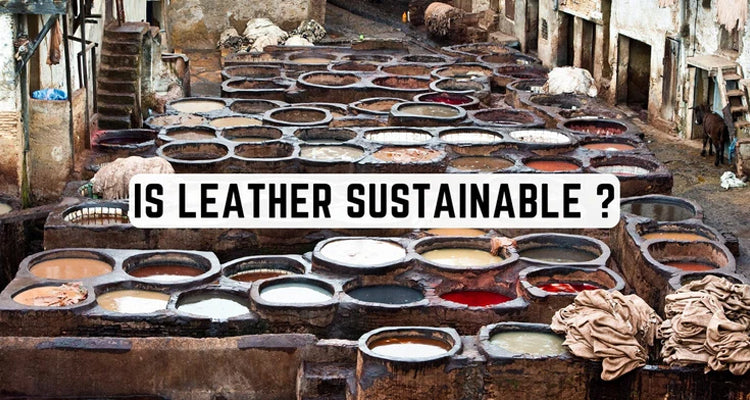Is Leather Sustainable?
Introduction
Leather has long been a staple material in the fashion industry, used in everything from shoes and bags to jackets and accessories. However, as sustainability becomes a key concern for consumers, the ethical and environmental impact of leather production is under increasing scrutiny. This article explores whether leather is truly sustainable, covering its environmental footprint, ethical considerations, and ways to make leather production more sustainable.
What is Leather?
Leather is a durable and flexible material made from animal hides, primarily from cows, sheep, and goats. It has been used for centuries due to its longevity and versatility. The history of shearling jackets and other leather garments traces back to early civilizations, where people relied on animal hides for warmth and protection. Today, leather is widely used in fashion, including men airforce shearling leather jackets, spikey jacket women, and sheepskin vests.
Sustainability of Leather
While leather is a natural material, its production raises several environmental concerns, including water usage, pollution, and deforestation.
Water Usage
Leather tanning, the process of treating raw hides to make them durable, requires large amounts of water. The traditional tanning process can consume up to 15,000 liters of water per ton of hides. Water waste from tanneries often contains harmful chemicals, further impacting the environment.
Pollution
One of the biggest environmental issues associated with leather production is chemical pollution. Chromium tanning, the most common method, releases toxic substances into water sources. Additionally, untreated wastewater from tanneries contributes to soil and air pollution, affecting local communities.
Deforestation
The demand for leather indirectly contributes to deforestation. Large areas of forests are cleared for cattle ranching, particularly in regions like the Amazon. This deforestation not only threatens biodiversity but also contributes to climate change by reducing carbon absorption.
What are the Ethical Considerations of Leather?
Sustainability is not just about environmental factors but also about ethical concerns, such as animal welfare and working conditions in the leather industry.
Animal Welfare
Leather production raises concerns about the treatment of animals. While leather is often a byproduct of the meat industry, some argue that demand for high-quality leather encourages factory farming and unethical treatment of animals.
Working Conditions in Leather Production
Many tanneries are located in developing countries where workers face poor working conditions, exposure to toxic chemicals, and inadequate wages. Efforts to improve labor conditions are necessary to make leather a more ethical choice.
Comparison to Other Materials
To determine whether leather is sustainable, it's essential to compare it with synthetic and natural alternatives.
Synthetic Materials
Many vegan alternatives, such as PU and PVC leather, avoid animal cruelty but have their sustainability issues. These synthetic materials are often petroleum-based, non-biodegradable, and contribute to microplastic pollution.
Natural Alternatives
Some eco-friendly leather alternatives include mushroom leather, pineapple leather (Piñatex), and cork leather. These materials offer a sustainable and cruelty-free option for consumers looking to reduce their environmental footprint.
What Initiatives Can Be Taken to Make Leather Production More Sustainable?
There are several ways the leather industry can become more sustainable, including the use of eco-friendly materials, improved production processes, and industry certifications.
Use of Sustainable Materials
Brands are increasingly adopting vegetable-tanned leather, which uses natural tannins from plants instead of toxic chemicals. Additionally, recycled and upcycled leather reduces waste and the demand for new raw materials.
Improved Production Processes
Innovative techniques, such as waterless tanning and biodegradable treatments, are being developed to minimize leather’s environmental impact. Some manufacturers are also adopting closed-loop water systems to reduce water waste.
Industry Certifications
Certifications such as the Leather Working Group (LWG) and OEKO-TEX® ensure ethical and sustainable leather production. These standards promote environmentally responsible practices and fair labor conditions in the leather industry.
FAQs: Is Leather Sustainable?
1. Is leather more sustainable than synthetic alternatives?
Leather has a longer lifespan than synthetic materials, making it a more sustainable choice in the long run. However, ethical and environmental concerns must be considered when purchasing leather products.
2. What are the most sustainable types of leather?
Vegetable-tanned leather, recycled leather, and leather from ethically raised animals are among the most sustainable options available.
3. Can leather production be ethical?
Yes, ethical leather production is possible through responsible sourcing, better working conditions, and sustainable tanning methods. Supporting brands that follow ethical practices helps promote sustainability in the industry.
4. Are there stylish and sustainable leather alternatives?
Yes! Many fashion brands now offer stylish eco-friendly options, including plant-based leather. Whether you're looking for a spiked pink leather jacket or a spiky jacket, sustainable options are becoming more accessible.
Final Thoughts
Leather remains a controversial material in the sustainability debate. While it is a natural and durable material, its production can have significant environmental and ethical consequences. However, the leather industry can become more sustainable with advancements in sustainable practices, eco-friendly alternatives, and responsible consumer choices. Whether you prefer classic shearling jackets or trendy spikey jacket women, being informed about your purchases can help make a positive impact on the planet.
By supporting brands that prioritize sustainability, you can enjoy leather fashion while contributing to a more ethical and eco-friendly industry.
You May Also Like:⤵
- 5 Best Occasions to Wear a Leather Jacket
- What is Cowhide Leather?
- What is Lambskin Leather?
- Caring for Your B3 Bomber Jacket: A Comprehensive Guide to Longevity
- Top 10 Expensive Leather Jackets in the World in 2025
- What to Wear with a Leather Jacket in 2025?
- Understanding Why Shearling Jackets Have Become Trendier Nowadays
- Why Do Leather Jackets Have Shoulder Straps?

